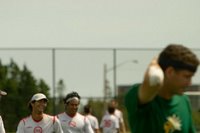In a standard tournament you can expect to play 3 pool play games, 1 crossover, and a quarters, semis, and finals. A total of 7 games over a period of 36 hours. At the minimum you'll play 5 games, and I've played 9 over a 2 day tournament. In this post, I'm questioning what is a reasonable amount - even sane amount.
 Pictured Above: Roy guys walking off the field at Canadian Nationals 2006. Dante Reino in the back on the left and Stefan Rappazzo to the right.
Pictured Above: Roy guys walking off the field at Canadian Nationals 2006. Dante Reino in the back on the left and Stefan Rappazzo to the right.Let us start by addressing one of the key factors that equates here; that is, how many people are on your team. Next, let's make some assumptions:
- There are approximately 14+10 points in a game = 24
- Each point takes an average of 3 minutes
- 21 players - 8 points per game - 56 points per weekend - 3 hours of high strain exercise
- 14 players - 12 points per game - 84 points per weekend - 4.5 hours of high strain exercise
- 7 players - 24 points per game - 168 points per weekend - 8 hours of high strain exercise
Professional athletes don't keep up this level of intensity over a short period of time. Let us look at some amateur sports tournament setups:
- Hockey is traditionally 2/3 games in pool play and a semis and finals
- Soccer tournaments are similar 2/3 games + a semi and a final
- Baseball tournaments in many cases start in a round of 16 (4 games if you win)
So, are we playing too much at ultimate tournaments, or are these other sports limited by playing facilities, and referee costs.
I would argue that one of the challenges in our sport is that seeding is challenging and we need the round robin play (even with past records). Seeding gets harder going from year to year. Also, many of us are cultured to expect to play many games (value for money) if we travel more than 2 hours.
I'm like all of you. I like to see value for my money, but maybe we should rethink the tournament format and enjoy our weekends a little more instead of constant playing. I don't think it's healthy, and I've seen a number of bodies that agree with me. The trick will be changing the culture of the sport. The real concern is when you wake up the next day and you're completely sore. That's risky.
PJ


3 comments:
Maybe your diet of coke and chips is affecting your ability to run for 7 games, resulting in your need to play the O line. :)
Ha but really most competitive teams carry your reasonable amount of players, 14-21 to a tournament. Their bodies have come to expect the long play. It's not a matter of too much play on a weekend; rather what is the person's work out routine and how physically fit are they during the season and preseason?
Teams that can't handle the physical endurance of an ultimate tournament should have larger teams enabling the required rest each individual needs.
Plus, most pool play is not that grueling of a challenge and those games tend to end quicker with fewer points. I think it is also a plus to have pool play only to 13. Furthermore, it's like an unwritten rule that most teams don't play their last game unless it's the finals.
I would vote value for money and I enjoy the set up tournaments currently have.
To anonymous, I agree that the large roster is probably the best solution to the length of the tournament.
As for the pool play easiness, the latest trend in Open ultimate is power pools, and I don't believe that pool play is easy anymore unless you're one of the top teams in the continent.
PJ
We've taped several games this season and then cut out the time between pulls and stoppages. It turns out that the actual disc in play time is about half of the game time. This means that instead of the average point being 3 minutes of exercise, it's only one and a half. Add to this the reality that most players are stationary or slow moving for part of that because they're waiting for someone else to clear, playing O against a zone or handling, even a team of seven players is doing less than four hours of high strain exercise a day. Though four hours of high strain exercise is nothing to sneeze at.
Post a Comment